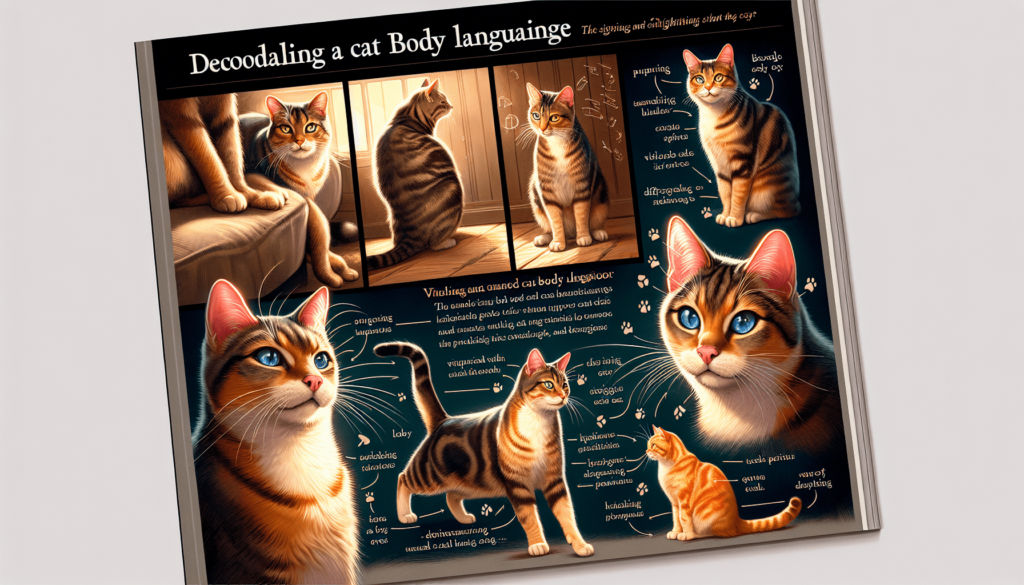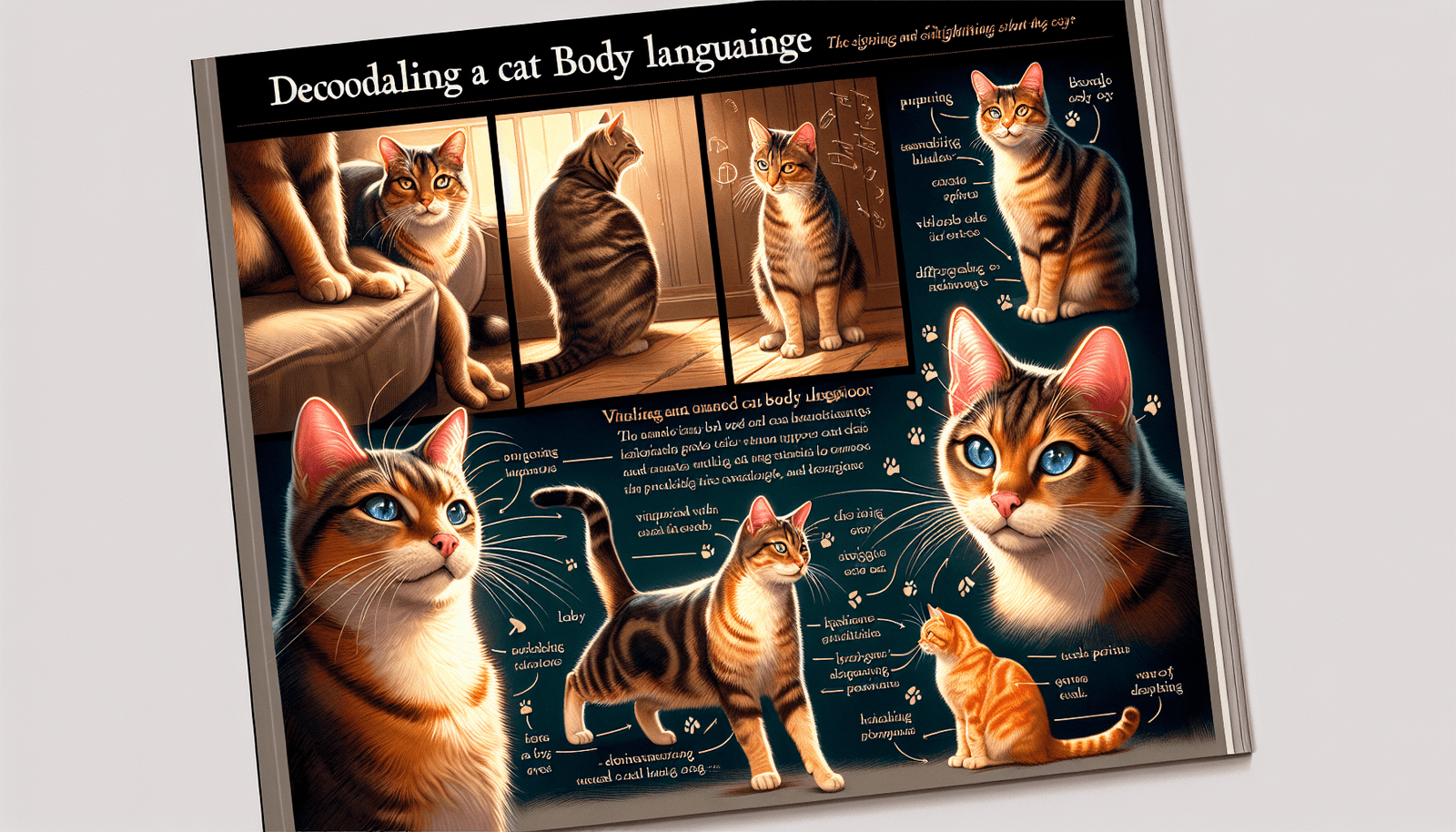Have you ever wondered what your feline companion is trying to communicate with you through their body language? Cats have a unique way of expressing their feelings and intentions through subtle cues that can often go unnoticed. By understanding and decoding these various signals, you can gain valuable insights into your cat’s emotions and needs. In this article, we will explore the fascinating world of cat body language, helping you decipher what your cat is trying to tell you without uttering a single meow.
Understanding Cat Body Language
As a cat owner, it is essential to understand and interpret your furry friend’s body language. Cats communicate primarily through their body movements and expressions, and being able to decipher these signals will help you establish a deeper connection with your pet. From feline facial expressions to tail signals and vocalizations, every aspect of their body language conveys a specific message. By learning to interpret these cues, you can better understand your cat’s needs, emotions, and overall well-being.
Recognizing the Importance of Cat Body Language
Cats are known for their independent and mysterious nature, but that doesn’t mean they don’t communicate. In fact, understanding your cat’s body language is crucial in creating a harmonious environment for both of you. By recognizing their signals, you can provide appropriate responses, fulfill their needs, and prevent potential conflicts. Moreover, being attentive to their body language allows you to monitor their health and address any discomfort or distress promptly.

Why Understanding Cat Body Language is Essential for Cat Owners
Understanding cat body language is essential to being a responsible and caring cat owner. By deciphering their signals accurately, you can respond appropriately to their needs, whether it is providing food, giving them space, or offering comfort. This understanding enhances the overall quality of life for both you and your feline companion, creating a happier and healthier bond. Additionally, by being aware of their body language, you can ensure their safety and prevent any potential accidents or conflicts.
Interpreting Feline Facial Expressions
A cat’s face can provide valuable insights into their emotions. By paying attention to their eyes, ears, and whiskers, you can gain a deeper understanding of what your cat is trying to convey.
The Message Behind Their Eyes
Cats’ eyes are incredibly expressive and can reveal a wide range of emotions. Dilated pupils often indicate excitement or fear, while partially closed eyes suggest contentment and relaxation. If your cat maintains prolonged eye contact with you, it may be a sign of trust and affection. However, a direct stare accompanied by squinted eyes can be an indication of aggression or unease.
Deciphering Ear Positions
The position of a cat’s ears is a clear indicator of their mood. Upright ears facing forward usually mean that your cat is alert and interested in their surroundings. On the other hand, flattened ears against the head suggest fear, anxiety, or aggression. If your cat’s ears are constantly twitching, it may indicate that they are feeling irritated or overstimulated.
Understanding Whisker Movements
Whiskers are not only adorable but also serve as essential sensory tools for cats. When your cat’s whiskers are relaxed and pointing forward, it signifies a calm and content state. However, if their whiskers are pulled back or pointing sideways, it may indicate insecurity or fear. Paying attention to these subtle movements can provide insight into your cat’s level of comfort and confidence.

Decoding Tail Signals
A cat’s tail is one of the most expressive parts of their body. By understanding the different positions and movements of their tail, you can uncover valuable information about their mood and intentions.
The Different Positions and Movements of a Cat’s Tail
A relaxed and slightly curved tail, often seen in a question mark shape, indicates that your cat is content and comfortable. Conversely, a puffed-up tail is a sign of fear or aggression, which means your cat is feeling threatened or cornered. A tail tucked tightly between the legs suggests extreme fear or anxiety. Pay attention to the overall posture and context to interpret the tail signals correctly.
What the Tail Position Indicates
The position of your cat’s tail can give you clues about their emotions. A high, vertical tail suggests confidence and happiness, while a tail held low indicates submission or fear. When a cat’s tail is gently swaying from side to side, it signifies a relaxed and friendly disposition. However, a vigorously wagging tail is a warning sign, indicating annoyance or aggression. Understanding these tail positions will help you respond appropriately to your cat’s needs.
Reading Vocalizations and Sounds
Cats communicate not only through their body language but also through a variety of vocalizations and sounds. By familiarizing yourself with the meanings behind these sounds, you can better understand what your cat is trying to tell you.
Meows, Purrs, and Chirps: What Do They Mean?
Meowing is a sound that cats primarily use to communicate with humans rather than with other cats. The tone and length of a meow can convey various messages, such as hunger, wanting attention, or even a simple greeting. On the other hand, purring is a sign of contentment, relaxation, and happiness. Chirping or trilling sounds often indicate excitement or curiosity, especially when they encounter something interesting or when they want to play.
Understanding Hissing, Growling, and Yowling
Hissing, growling, and yowling are vocalizations associated with negative emotions such as fear, aggression, or pain. These sounds serve as warnings or defensive mechanisms to ward off perceived threats. If your cat hisses or growls, it is essential to give them space and identify the cause of their distress. Additionally, yowling can be a sign of discomfort, such as when a female cat is in heat or if your cat is in pain or distress. It is crucial to consult with a veterinarian if these sounds persist or if you suspect any underlying health issues.
Understanding Body Postures
Cats communicate a wealth of information through their body postures. By observing the subtle nuances of their stance, you can decipher their emotions and intentions more accurately.
The Characteristics of Relaxed and Playful Postures
A relaxed cat typically has a loose and open body posture. They may lie on their side, exposing their belly, which is a sign of trust and contentment. When a cat is in a playful mood, they may crouch down with their hindquarters raised high, ready to pounce. Their tail may wag gently, and they may make quick, playful movements with their paws. Recognizing these relaxed and playful postures will allow you to engage in positive interactions with your cat.
Identifying Defensive and Aggressive Stances
In contrast to relaxed postures, defensive and aggressive stances indicate that your cat feels threatened or challenged. An arched back, puffed-up fur, and a sideways hop can be signs of fear or aggression. Ears flattened against the head, a low tail position, and a crouched body suggest readiness to strike or defend themselves. It is crucial not to approach or provoke a cat displaying these aggressive postures and to create a safe environment for them.
Recognizing Subtle Changes in Body Language
Cats’ body language is not always black and white; they can convey subtle changes through small movements and postures. A flicking tail, for example, may indicate anticipation or irritation. Slow, deliberate movements and a fixed gaze can mean they are assessing their surroundings or focusing on a potential prey. By paying attention to these nuanced signals, you can better understand your cat’s behavior and respond accordingly.
Interacting with Your Cat Based on Body Language
Once you have gained a basic understanding of your cat’s body language, you can adapt your interaction style to meet their needs effectively.
Creating a Positive Environment for Communication
To establish a strong bond with your cat, it is crucial to create a positive environment that encourages open communication. This includes providing them with a safe and comfortable space where they can retreat when they feel overwhelmed. Avoid forcing interactions or invading their personal space when they display signs of discomfort. By respecting their boundaries, you create an environment where they feel secure and can communicate more freely.
Responding Appropriately to Different Cat Signals
Each cat is unique, and their body language may vary slightly from one individual to another. It is essential to observe and understand your specific cat’s signals and respond accordingly. If they approach you with an upright tail and relaxed body posture, it indicates they are seeking attention and affection. On the other hand, if they flatten their ears, hiss, or growl, it is wise to give them space and allow them to calm down. By responding appropriately to your cat’s signals, you can build trust and enhance your relationship.
Building Trust and Bonding Through Body Language
Body language plays a significant role in building trust and deepening the bond between you and your cat. By being attentive to their needs and understanding their body language, you can effectively communicate your love and care.
Using Body Language to Strengthen Your Relationship with Your Cat
Understanding your cat’s body language allows you to communicate in a way that they find comforting and reassuring. By mirroring some of their relaxed postures, such as sitting or lying down at their level, you can create a sense of mutual understanding. Gently stroking and petting them in areas they enjoy, while paying attention to their body language, can further strengthen the bond you share.
Helping Cats Feel Safe and Secure Through Understanding
Sometimes, cats may exhibit certain body language cues that indicate fear, stress, or anxiety. By recognizing these signs, you have the opportunity to help them feel safe and secure. Providing them with a quiet and calm environment, utilizing pheromone products, and ensuring they have hiding spots can alleviate their anxiety and promote a sense of security. Additionally, respecting their personal space and avoiding sudden loud noises or unexpected interactions can go a long way in helping your cat feel more at ease.
Common Misunderstandings in Cat Body Language
While learning to interpret cat body language is crucial, it is essential to avoid misinterpreting their signals or making assumptions based on generalizations.
Avoiding Misinterpreting Cat Gestures
Cats, like humans, have their own unique personalities, and their body language may differ slightly from the generally accepted norms. Avoid assuming that every cat’s behavior or body posture can be interpreted in the same way. Take the time to observe and understand your individual cat’s body language to prevent miscommunication and unnecessary misunderstandings.
Recognizing Individual Differences in Body Language
Different cats may have distinct ways of communicating their emotions and needs through body language. While certain signals may be universal, such as a relaxed or aggressive posture, it is essential to pay attention to the unique characteristics of your cat’s body language. By recognizing their individuality, you can better understand their preferences, fears, and desires, thereby strengthening your connection.
Signs of Stress and Fear in Cats
Cats can experience stress and fear in various situations, and their body language reflects these emotions. Recognizing the signs of stress and fear is essential in providing comfort and support to your cat.
Identifying Stressful Situations and Body Language
Stressful situations can range from changes in the environment, such as moving houses or introducing new pets, to visits to the veterinarian or encountering unfamiliar people. Cats may display specific body language cues when they are stressed, such as excessive grooming, urinating outside the litter box, dilated pupils, or hiding for extended periods. By identifying these signs, you can take steps to alleviate their stress and create a more calming environment.
Providing Comfort and Reducing Stress
If your cat is displaying signs of stress or fear, it is essential to provide them with comfort and support. This can be achieved by creating a safe space where they can retreat, utilizing toys or puzzle feeders to engage them mentally and physically, and using calming techniques such as gentle stroking or playing relaxing music. Additionally, consulting with a veterinarian or a professional animal behaviorist can provide valuable guidance on reducing stress and promoting overall well-being.
Conclusion
Understanding cat body language is a valuable skill that every cat owner should possess. By decoding their facial expressions, tail signals, vocalizations, and body postures, you can build a strong bond with your cat and ensure their well-being. Remember, each cat is unique, and their body language may vary slightly, so take the time to observe and understand the individual characteristics and preferences of your feline companion. By enhancing your communication through body language, you will create a harmonious and fulfilling relationship with your beloved cat. Continued learning and observation of cat body language will only further enhance the connection and enrich both your lives together.

